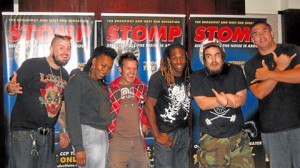
“STOMPERS” (from L): Angus H. Little, Melanie Joseph, Johannes Bohun, Nigel Clarke, Mikey Lantis and Andy Pang pocholo concepcion
Colorful and animated best describe the performers in “Stomp”—the percussion, dance and comedy show which opens tonight at 8 at the Cultural Center of the Philippines. It runs until October 23, with Saturday and Sunday matinees at 3 p.m.
Six of the eight cast members met the Philippine media last Thursday; they all looked fun to be with in their street clothes, easy smiles and flippant gestures.
Angus H. Little easily stood out with his blue and red punk hair, which was not exactly a Mohawk, but looked more like fish fins. The Australian native said he worked as a clown before getting into “Stomp”—which has been his main gig for the past eight years.
Nigel Clarke is British and black and had braided hair. He majored in dance in college, which came in handy when he joined “Stomp.” He’s been doing it for 13 years.
Melanie Joseph, Johannes Bohun, Mikey Lantis and Andy Pang have been in the cast for 13, 10, 6 and 5 years, respectively. Which is like saying these guys must love what they’re doing for them to last that long.
“Stomp” has been running at the Orpheum Theatre in New York for 18 years, and is on its 10th year at the Ambassadors Theatre in London. It has won various awards including an Olivier for best choreography in a West End Show.
For a quick overview of the show, the Inquirer had a chat via e-mail with Steve McNicholas, who with Luke Cresswell created “Stomp” in 1991.
Why do you think words are not necessary in presenting “Stomp”?
Rhythm is the only language needed in “Stomp” and it’s something everyone understands, no matter where they live in the world. Everyone has a heartbeat, everyone tries to create order out of the cacophony of life around them. It’s a very basic instinct.
And everyone, at some point in their lives, feels the urge to move to a rhythm—whether through dance, or simply through walking across the street. Rhythm is in our bones, and so we can all understand that.
“Stomp” doesn’t have any musical style, other than a celebration of pure physical rhythm, so it’s also open to anyone, whether they listen to jazz, pop or classical music. Rhythm is a great leveler, but so is humor, and there is a lot of physical humor in “Stomp” that doesn’t need words either.
Who makes the rhythmic patterns in the show? Do the performers add their own inputs?
Luke Cresswell creates almost all of the rhythmic patterns and I help shape them into complete routines and into the show. But there’s room in all of our pieces, however complex and strict they may be, for the performers to add their own flavor to the performance. There are lots of solo moments where it’s really up to the individual performer to get creative!
How many times have the routine numbers changed since the show was first created?
They are constantly in flux, to be honest. We never stop working on the show, refining it. Every three years or so we remove some pieces and add others, and make big changes to the show, but we’re always listening to the pieces and figuring ways to make it better.
It was mentioned that the energy and action in the show is comparable to that of a football match. What kind of injuries have the performers suffered through the years?
Yes, it’s a high-energy show, very physical, and one physiotherapist compared it to a football match in terms of exertion! “Stomp” performers are susceptible to the kind of injuries that dancers might get, so they have to be careful regarding their ankles, knees and backs. Of course they can also get rapped knuckles in “Stomp.”
Many injuries have been self- inflicted: performers hitting themselves with a broom or a drumstick. Fortunately we haven’t had major injuries, but minor injuries go with the territory when you work in physical theater or dance, just like sports.
The show is suitable for all ages. But has there been an instance when somebody in the audience expressed dissatisfaction, or perhaps complained about the volume of the noise?
Complaints are very, very rare! We have played to millions of audiences over 20 years, and we really haven’t had many complaints at all. People are usually surprised that the show isn’t loud all the time, and that lots of pieces are quiet, and quite delicate. If it was one long, loud thrash of drumbeats, I don’t think it would have been very successful.
When we opened the show in New York, there was an apartment connected to the back of the theater; I think they’re probably the only people that complained about the noise.
What was the most unique compliment that the show has gotten so far?
I think the best compliment is when people tell me they didn’t like the idea of it, didn’t want to see it, but once they did, they loved it! I think sometimes people can have an expectation of what the show is like, which gets turned around when they see it onstage.